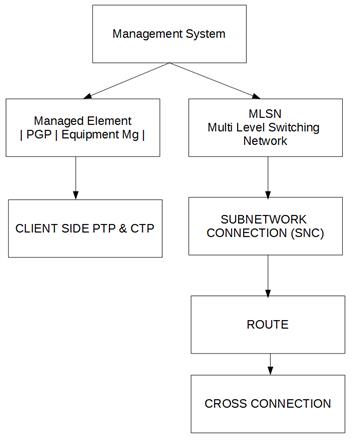Optical Networks basics and Common words
Contents
- Getting Started
- Architecture of Network
- Properties of a Good Optical Network
- Multi Technology Network Elements
- Optical Network Ports
- Equipment Modelling
- Roles of Management System
- Transmission Technologies and signals
- Signal vs Rate Table
- Communication Interface
- OverAll Network Map
Getting Started
How it would be?
All Optical Network links are connected to the internet through the MPLS Multi Protocol Lable switching. So that would be the gateway to the internet for optical lines. Which is also has Session Initiation Protocol - SIP with it. The figure shown below explains the connectivity.
Normal Blocks of an Optical Network
Optical Network Block

Links Associated with the above shown Image
- Optical lines
- ADSL (Asynchronous Digital Synchronous Link)
- EFM links (Ethernet Fiber Modem Link)
SIP will helps for the functions shown below,
Functions
1. User Registration
- It collects the user locations and details who are participating.
2. User Availability
- It determine the user availability whether they will answer call.
3. Session Setup
- It controls the end point telephone to be ring or not.
3. Session Management
- It has total control to manage the calls like changing into 3 way calls conference, call termination, Transfer call, etc.,
What MPLS does?
- It encapsulates packets of various network protocols.
- It supports the technologies like T1/E1, ATM, Frame Relay, and DSL.
- Due to the switching methods like ASIC, TCAM and CAM its goal to increase speed is no longer relevant.
- It is confined by the limited traffic engineering.
Architecture of Network
Due to this connection environment, The network looks like N number of spanning trees are conncted to the main end point of the network which manages the totoal network.
Basic Architecture of an Optical Network

MSTP
Multiple Spanning Tree Protocol is the protocol which is used in this optical Transportation environment. This is commonly known in the Synchronous digital hierarchy - SDH topology.
Properties of a Good Optical Network
It should have,
- SDH - Synchronous Digital Hierarchy (or) SONET Synchronous Optical Hierarchy
- DWDM - Dense Wavelength Division Multiplexing
- Fault Management and Rout Cause Analysis
- Northbound and Southbound Interfaces
- CORBA
- MTOSI
- OSS/J
- PTP Physical Terminal Point
- CTP Connection Terminal Point
- ME Managed Element (view by the NMS System)
- SNC Sub-network Connection
- aEnd
- zEnd
Multi Technology Network Elements
It is widely manages and supports the management of these technologies:
- SONET/SDH,
- PDH, Plesiochronous Digital Hierarchy
- DWDM,
- Ethernet,
- DSL, Digital Subscriber Link
- ATM, Asynchronous Transfer Mode
- Frame Relay, and Control Plane management.
SDH/SONET
- Synchronous clock operation followed in the network elements. It is better than PDH.
- SDH is the only key to use multi point networking.
PDH
- Plesiochronous means variable clocks are followed in multiplexing areas. Due to that each node will differ within tolerance of few clock periods.
- PDH is not suitable for growing network Traffic.
Optical Network Ports
PTP
- This is the Physical Terminal Point of a network where clients exists.
- Physical Terminal Point contains more or one CTP.
CTP
- Connection Terminal Port communicates through the PTP.
- This is the actual end of the client where the service ends.
- CTP Associated with PTP by STM-4 (Synchronous Transport Module - 4) prototype.
Equipment Modelling
Network Elements
These can be separated as shown below,
-
Manageable Components
- Circuit Pack/Field replaceable unit
- Card
- Fan Unit
- Power Supply
-
UnManageable Components
- Rack
- Shelf
- Slot
- Sub_Slot
Normally the port is the end of the network that can be derived by,
Port Name
Port = RACK:1,SHELF:1,SLOT:1,SUB_SLOT:1,PORT:2
Path of the Circuit to the Cross connection
Service/ Circuit —-> SNC_n —-> Route_n —-> CC_n
Note: All components above are interconnected by their own siblings
Roles of Management System
Element Management System

CC_n
Cross Connection is the bridge between two CTP. It can be protected. It allows the connection which is in active.
PGP
Pretty Good Privacy consists of,
- Compatibility
- Confidentiality
- Digital signatures
- Web of trust
- Certificates
Above shown Multi-level check has been done for the privacy through the PGP.
Transmission Technologies and Signals
Technologies
- PDH
- ETHERNET
- SDH
- OTN
Signal
- E1, E2, E3, E4
- Ethernet
- STM_1, STM_4, STM_16, STM_64
- OTU_1, OTU_2, OTU_3, OTU_4
Bandwidth
- 2 - 140 (2, 8, 34, 140 Mbps)
- 1-10 Gbps
- 0.155, 0.622, 2.5, 10 Gbps
- 2.5, 10, 40, 100 Gbps
Signal Table
| Signal Type | Rate |
|---|---|
| E1 | 2 Mbps |
| E2 | 8 Mbps |
| E3 | 32 Mbps |
| E4 | 140 Mbps |
| Ethernet | 1-10 Gbps |
| STM_1 | 0.155 Gbps |
| SMT_4 | 0.622 Gbps |
| STM_16 | 2.5 Gbps |
| STM_64 | 10 Gbps |
| OTU_1 | 2.5 Gbps |
| OTU_2 | 10 Gbps |
| OTU_3 | 40 Gbps |
| OTU_4 | 100 Gbps |
Communication interfaces in Optical lines
- Northbound Interface (Low level element to High level element)
- Southbound Interface (High level element to Low level element)
OverAll Network Map
Reference
For further information see also : RF-wireless-world
- https://www.juniper.net/documentation/en_US/junos/topics/concept/interface-security-t1-and-e1-understanding.html

Related Posts
Wireless Transceiver Design Considerations
Wdm In Optical Network